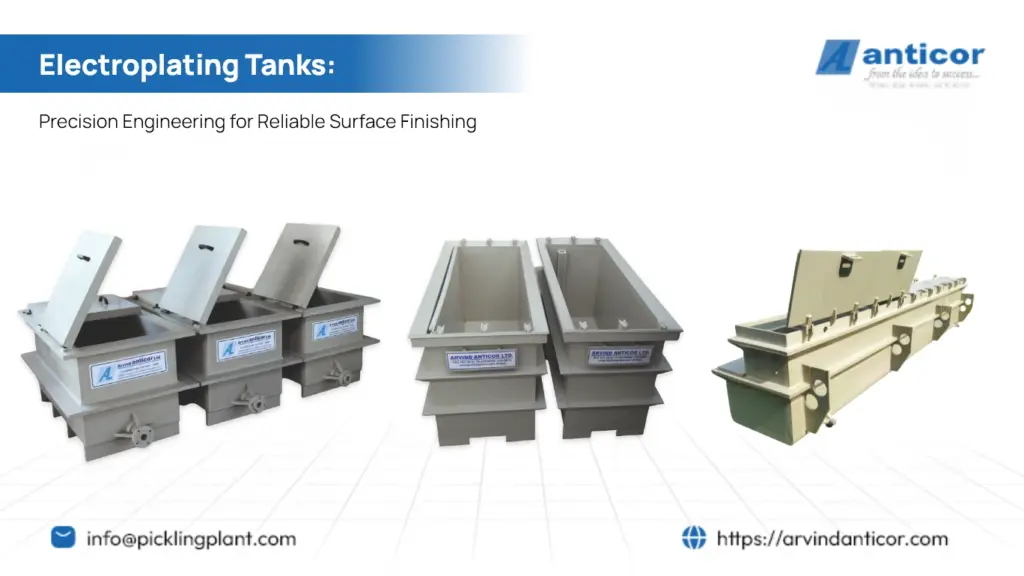Electroplating tanks play a crucial role in achieving durable, high-quality finishes across industries like automotive, aerospace, and electronics. At Arvind Anticor, our precision-engineered tanks provide the stability needed for reliable and consistent results. In this post, we’ll explore why investing in Arvind Anticor's electroplating tanks is key to optimal performance and long-lasting results.
Understanding the Role of Electroplating Tanks
An electroplating tank holds the electrolyte solution in which the electroplating process occurs. During electroplating, metal ions in the solution coat the surface of a product, creating a thin, durable layer of metal. This process requires precise conditions, which the electroplating tank must support, including optimal temperature, pH, and chemical composition. Given the exposure to harsh chemicals and the need for process stability, electroplating tanks must be constructed with materials that are not only chemically resistant but also structurally sound.
Materials Matter: Choosing the Right Material for Electroplating Tanks
The materials used in the construction of electroplating tanks are crucial to their effectiveness and lifespan. Here are the key materials often considered for these tanks:
- Polypropylene (PP): Known for its excellent chemical resistance, polypropylene is often used in electroplating tanks for its durability and low weight. It can withstand various chemicals and is ideal for both hot and cold plating processes. Additionally, it’s resistant to cracks and corrosion, which makes it a long-lasting choice for electroplating environments.
- FRP (Fiber-Reinforced Plastic): FRP combines resin with fiberglass reinforcement, providing excellent chemical resistance and structural strength. It’s highly customizable and can be tailored to meet specific needs, such as handling higher temperatures or particularly corrosive chemicals.
- HDPE (High-Density Polyethylene): HDPE is another lightweight, chemical-resistant option commonly used in industrial settings. It’s known for durability and resistance to cracking and is used in both storage and electroplating applications.
Key Features of High-Quality Electroplating Tanks
When it comes to electroplating tanks, precision and durability are essential. Here’s what to look for:
- Chemical Resistance: Tanks must withstand aggressive chemicals and prevent leakage or corrosion over time. Polypropylene and FRP are top choices for high chemical compatibility.
- Temperature Stability: Electroplating processes often require high temperatures, so the tank should be able to handle temperature variations without deforming or compromising safety.
- Structural Integrity: Tanks must be built to endure long-term use in industrial settings. High-quality construction ensures stability, with options like reinforced frames or dual-layer walls to provide additional support.
- Customization Options: Every plating line has specific requirements. Tanks should be customizable to suit particular dimensions, capacities, and even features like overflows, heating coils, or fume extraction systems.
Why Quality Electroplating Tanks Matter
For any business investing in electroplating, high-quality tanks reduce operational risks, improve production efficiency, and support consistent results. Poorly constructed tanks, on the other hand, can lead to equipment damage, production delays, or worse, safety hazards from chemical spills. Choosing tanks engineered for durability and precision safeguards both equipment and staff, supporting productivity and long-term cost efficiency.
Electroplating Tanks by Arvind Anticor: Meeting Industrial Needs
At Arvind Anticor, we understand the critical role electroplating tanks play in high-stakes industries. That’s why our tanks are designed with premium materials like polypropylene, FRP, and HDPE. We customize our tanks to meet specific client needs, from size and temperature specifications to specialized fittings.
Our tanks prioritize:
- Long-lasting performance with chemical-resistant materials
- Safety-focused design for operator protection
- Efficient installation and maintenance to support production uptime
Conclusion
Electroplating tanks are the backbone of surface finishing processes, holding the materials that transform product surfaces for durability, strength, and appearance. With the right materials, design, and quality assurance, these tanks offer reliable performance in any industrial setting. Investing in high-quality electroplating tanks ensures that production standards remain consistent, safe, and efficient.
For more information on our electroplating tanks or to discuss your specific requirements, contact Arvind Anticor today. Let’s build the foundation for your successful electroplating operations.



